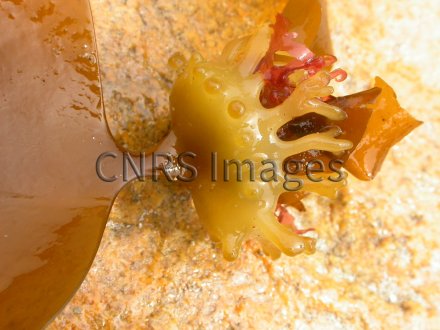Production year
2003

© Gaëlle CORREC /LBI2M / CNRS Images
20170093_0002
Observing the holdfast of a young furbellow (saccorhiza polyschides) at low tide on the foreshore in Roscoff. Kelp is able to perceive aggressions by bacteria, but also the presence of epiphytic algae that use it as an anchor, and herbivores such as helcions, which eat this type of seaweed. This seaweed is able to respond to such aggressions by activating a defensive metabolic process consisting in a respiratory burst, but also a halogen-based metabolic process, and more specifically, an iodine-based metabolic process. Among other benefits, these reactions help to repair wounds, as long as the damage is not too severe, causing tissue to swell around the helcion. Research has also identified signals - carried either internally by a weed, or else between weeds through the water - that remotely adjust these metabolic responses, suggesting the existence of a form of systemic communication. Scientists at the Roscoff biological research station are using kelp as a research model for halogen- and iodine-based metabolic processes, and for studying chemical communication by means of substances released into the water. Kelp also contains alginate, a known gelling agent with numerous applications in the food, pharmaceutical and cosmetics industries.
The use of media visible on the CNRS Images Platform can be granted on request. Any reproduction or representation is forbidden without prior authorization from CNRS Images (except for resources under Creative Commons license).
No modification of an image may be made without the prior consent of CNRS Images.
No use of an image for advertising purposes or distribution to a third party may be made without the prior agreement of CNRS Images.
For more information, please consult our general conditions
2003
Our work is guided by the way scientists question the world around them and we translate their research into images to help people to understand the world better and to awaken their curiosity and wonderment.